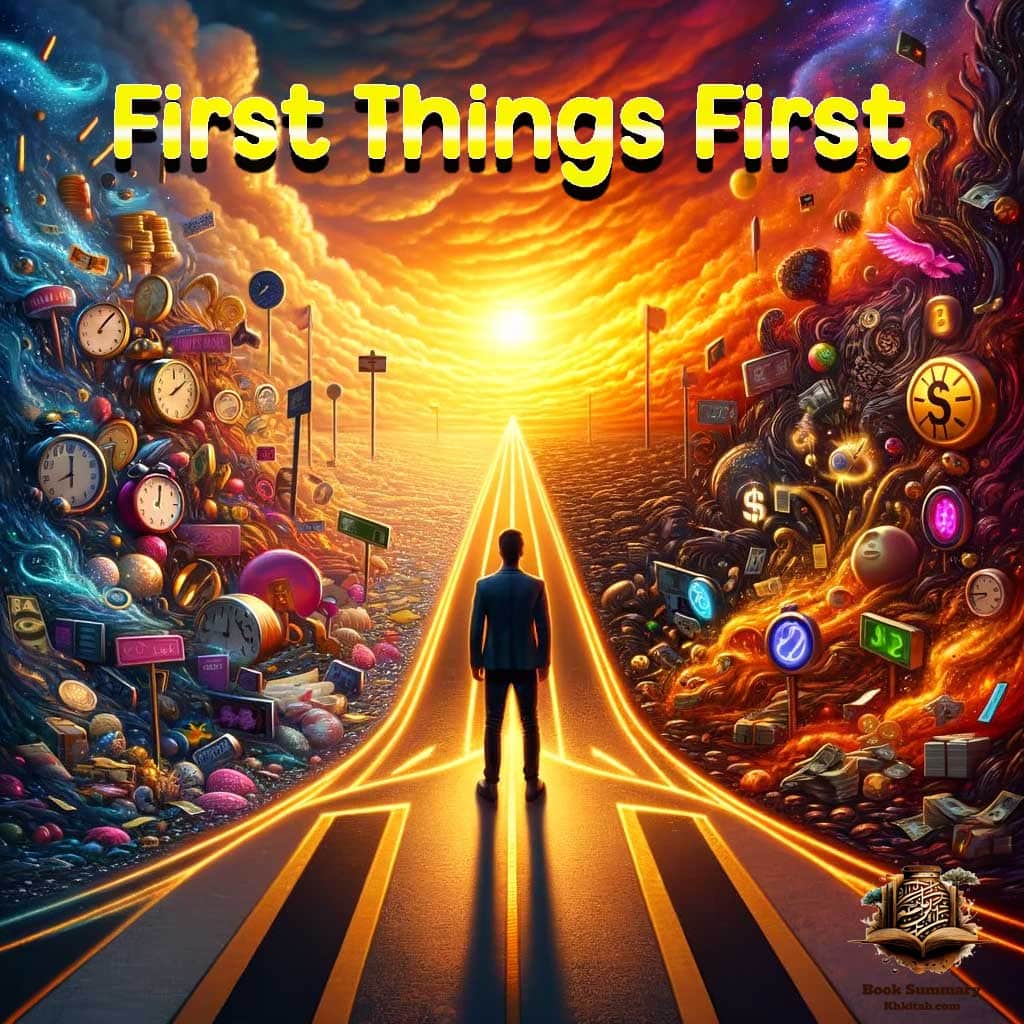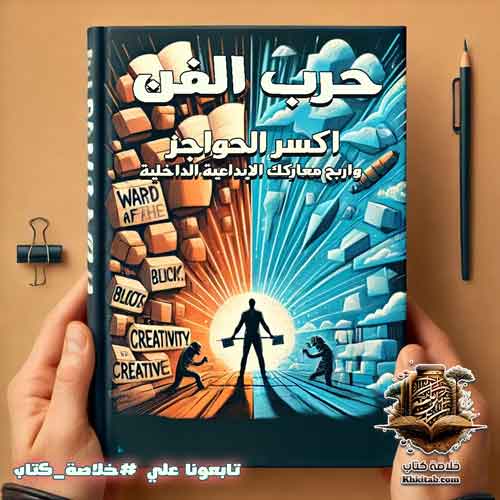First Things First Book Summary

In an increasingly complex and fast-paced world, “First Things First” emerges as a guiding beacon for those seeking effectiveness and balance in their lives. Authored by Stephen Covey, A. Roger Merrill, and Rebecca R. Merrill, this book is not just a time management guide but an educational journey exploring how to achieve harmony between priorities and personal values.
“First Things First” is based on a fundamental idea: success and accomplishment do not just come from efficiency in managing time, but from the ability to identify what is truly important and giving it precedence. The book challenges traditional time management methods, proposing an approach that focuses on values and principles rather than merely responding to the most urgent demands.
Covey and his colleagues present a time management matrix that categorizes tasks into four quadrants based on their urgency and importance. Through this matrix, readers learn to focus not just on urgent tasks but on those that are deeply important and have a long-term impact. The book emphasizes that focusing on such tasks is what achieves true balance and personal growth.
إقرأ أيضا:The Art of Talking to Anyone: Navigating the Landscape of Effective Communication“First Things First” goes further by offering practical tools for identifying personal values and translating them into goals and action plans. The book also addresses the importance of building healthy relationships and collaborating with others, considering it an integral part of successful priority management.
As a comprehensive guide for anyone looking to improve the quality of their personal and professional life, “First Things First” provides deep insights into living in alignment with one’s deepest values and goals. It teaches us how to make decisions based on what is truly important, not just what is urgent. In an era dominated by distractions and pressures, this book is a necessary guide for those striving for a balanced and achievement-filled life.
“First Things First,” a compelling work by Stephen Covey, A. Roger Merrill, and Rebecca R. Merrill, reimagines the concept of time management, shifting the focus from a clock-driven approach to a values-driven philosophy. This book isn’t just about managing schedules; it’s about aligning one’s time with their deepest convictions and priorities.
إقرأ أيضا:The Reproach of Hunger: Navigating the Challenges and Solutions in a Globalized EraThe Principle-Centered Approach
The traditional time management methods often emphasize efficiency and productivity, focusing on checking off tasks from a to-do list. However, “First Things First” introduces a radical shift – from being merely efficient to being truly effective. It suggests that effectiveness comes not from how much we do but from how much we accomplish what truly matters. Covey and his co-authors argue that this approach starts with a clear understanding of your deepest values and life goals.
Redefining Productivity
One of the key narratives in the book revolves around the story of a seminar attendee who participates in an eye-opening exercise. The presenter places a large, empty jar on a table, alongside rocks, pebbles, sand, and water. The challenge? To fit everything into the jar. The attendee initially focuses on the smaller items, only to realize they can’t fit the larger rocks afterward. This metaphor strikingly illustrates the book’s philosophy: if you don’t prioritize your “big rocks” – your most important tasks aligned with your core values – you’ll never fit them in amongst all the smaller, less significant tasks.
إقرأ أيضا:The Man Who Mistook His Job for His Life: Balancing Work and EmotionsImplementing the Quadrant II Focus
At the core of the book’s methodology is the Time Management Matrix, dividing tasks into four quadrants based on their urgency and importance. Covey emphasizes the necessity of focusing on Quadrant II activities – tasks that are important but not urgent, like relationship building, personal development, and long-term planning. This quadrant is often neglected in traditional time management, which tends to prioritize urgent but often less important tasks (Quadrant I) or succumb to time-wasting activities (Quadrant IV).
Living a Principle-Centered Life
“First Things First” doesn’t just stop at prioritization; it encourages readers to reflect on their lives holistically. Covey urges readers to develop a personal mission statement, a clear declaration of one’s values and goals. This becomes a guiding framework for daily decision-making, ensuring that one’s actions consistently align with their principles.
Conclusion
By challenging traditional time management techniques and urging a principle-centered approach, “First Things First” offers more than just productivity tips; it provides a blueprint for a fulfilling and purpose-driven life. This book encourages readers to not just do things right but to do the right things – an invaluable lesson in a world brimming with distractions and demands.
“How Does the Time Management Matrix in ‘First Things First’ Transform Our Approach to Tasks?”
In “First Things First,” authors Stephen Covey, A. Roger Merrill, and Rebecca R. Merrill introduce a groundbreaking concept known as the Time Management Matrix. This matrix is a pivotal tool that categorically revolutionizes our approach to handling tasks by dividing them into four distinct quadrants based on two critical factors: urgency and importance. This matrix isn’t just a method for organizing tasks; it’s a strategic framework that guides us in aligning our daily activities with our deepest values and long-term objectives.
Understanding the Four Quadrants
The genius of the Time Management Matrix lies in its simplicity and profound impact. The first quadrant (Q1) contains tasks that are both urgent and important. These are the crises and deadlines that demand immediate attention. While necessary, the book cautions against spending too much time in this quadrant, as it can lead to stress and burnout.
Quadrant II (Q2) is where the essence of effective time management lies. These tasks are important but not urgent, encompassing activities like planning, relationship building, and personal development. Covey emphasizes that focusing on Q2 is key to long-term effectiveness and fulfillment. It’s about doing the right things, not just doing things right.
Quadrant III (Q3) includes tasks that are urgent but not important. These often appear important because they demand immediate attention, but they do not align with our core goals and values. Q4, the final quadrant, consists of activities that are neither urgent nor important, often serving as distractions.
The Story of the Professor and the Rocks
To illustrate the power of prioritizing Q2 tasks, “First Things First” shares a memorable story. A professor presents a jar, rocks, pebbles, sand, and water to his class. He fills the jar with rocks, asking if it’s full. When the class agrees, he adds pebbles, then sand, and finally water, demonstrating that there’s always room for more. The lesson? If you don’t put the big rocks in first, you won’t be able to fit them in later. The “big rocks” are the Q2 tasks – they must come first to ensure our most important tasks are not crowded out by the urgent but less significant tasks.
Applying the Matrix to Real Life
The Time Management Matrix isn’t just a theoretical concept; it’s a practical tool for everyday use. By categorizing tasks into these quadrants, we can visually understand where our time and effort are going. Are we firefighting in Q1, or are we investing in Q2, which yields long-term benefits? This realization often leads to an impactful shift in how we plan and execute our daily lives.
Conclusion
The Time Management Matrix from “First Things First” offers a transformative approach to how we perceive and handle our tasks. By understanding and applying this matrix, we learn to prioritize not just based on urgency but on true importance, aligning our daily actions with our broader life goals. This approach is crucial in a world where the urgent often overshadows the important, reminding us to focus on what truly matters in the long run.
In “First Things First,” authors Stephen Covey, A. Roger Merrill, and Rebecca R. Merrill delve into the profound process of creating a personal mission statement. This concept is a cornerstone of the book, emphasizing its pivotal role in aligning one’s daily actions with their deepest values and long-term goals. The book not only provides a step-by-step guide on crafting this personal mission statement but also illustrates its impact on decision-making and life management.
Crafting a Personal Mission Statement
The authors describe a personal mission statement as a written representation of one’s core values and what they aspire to be and achieve in life. It’s more than just a set of goals; it’s a compass that directs your life’s journey. The process of creating this statement encourages deep self-reflection, urging individuals to contemplate their roles, values, and ultimate life objectives.
The Role of Self-Reflection
One of the compelling stories in the book involves a busy executive who, amidst his hectic schedule, realizes he has lost sight of his true priorities. Through the exercise of drafting his personal mission statement, he rediscovers his core values and realigns his daily efforts with these rediscovered principles. This story exemplifies the transformative power of self-reflection in crafting a personal mission statement.
Guiding Daily Decisions
The personal mission statement is not just a document to be written and tucked away; it’s a living guide that influences daily choices and actions. Covey and his co-authors emphasize the statement’s role in decision-making processes. When faced with options or dilemmas, referring back to the personal mission statement helps in choosing paths that are congruent with one’s deeper values and long-term aspirations.
Impact on Life Management
The book highlights how a personal mission statement affects not just individual decisions but also overall life management. It serves as a framework for setting priorities, making commitments, and even for time management. The authors illustrate this through various examples where individuals, having defined their mission, are better equipped to manage their time and resources in a way that reflects their true priorities.
Conclusion
In “First Things First,” the personal mission statement is more than a tool; it’s a foundational element that shapes one’s approach to life. By crafting and adhering to a personal mission statement, individuals are empowered to make decisions and manage their lives in a way that resonates with their deepest values and goals. This process is crucial for anyone seeking to live a purposeful, directed, and fulfilling life, making the personal mission statement a vital aspect of effective life management.
Don’t Overthink It: Strategies for Easier Decisions and a Happier Life
In “First Things First,” a significant work by Stephen Covey, A. Roger Merrill, and Rebecca R. Merrill, the authors delve deeply into the art of setting priorities that resonate with one’s personal mission and core values. This aspect of the book is crucial as it shifts the focus from managing time to managing life itself, aligning daily tasks with long-term goals and values. The book offers various techniques and stories that illustrate the power and importance of aligning priorities with personal convictions.
Identifying What Matters Most
The starting point in “First Things First” for setting priorities is identifying what matters most to an individual. The authors encourage readers to reflect on their life’s roles – as a family member, professional, friend, and individual – and to consider what they find most valuable in each role. The book guides readers through a process of introspection to unearth their core values, which form the foundation of their personal mission statement.
The Role of the Personal Mission Statement
A key component in setting priorities is the personal mission statement, which the book discusses in detail. This statement acts as a personal constitution, a written declaration of what an individual stands for. It becomes the benchmark against which all decisions and actions are measured. By aligning priorities with this mission statement, individuals ensure that their daily actions are not just productive but also meaningful.
The Story of the Professor and the Jar
To illustrate the importance of setting priorities based on personal values, “First Things First” shares an enlightening story of a professor and a jar. The professor fills a jar with rocks (symbolizing major priorities), pebbles (secondary priorities), and sand (minor tasks). This metaphor demonstrates that if you don’t prioritize the rocks (major priorities), you won’t be able to fit them in your life if it’s already full of sand and pebbles.
Quadrant II Activities
The authors emphasize focusing on Quadrant II activities – tasks that are important but not urgent. These are often aligned with personal goals and values but are easily overshadowed by urgent, less important tasks (Quadrant I). By focusing on Quadrant II, individuals can ensure that they are dedicating time to their long-term goals and values, leading to a more fulfilling and balanced life.
Practical Steps for Priority Setting
“First Things First” provides practical steps for setting priorities. It involves regular planning sessions where individuals review their personal mission statement and align their weekly and daily plans with it. This process includes evaluating tasks, delegating or eliminating those that do not align with core values, and committing to activities that further one’s mission.
Conclusion
Through “First Things First,” readers learn that setting priorities is not just about choosing what to do but understanding why they are doing it. By aligning priorities with a personal mission and values, individuals can transform their approach to tasks, ensuring that their daily actions contribute to a meaningful and purpose-driven life. The book’s approach to setting priorities stands as a testament to managing life in a way that is both effective and enriching.
In “First Things First,” authors Stephen Covey, A. Roger Merrill, and Rebecca R. Merrill tackle the often overlooked but crucial aspect of time management: balancing the various roles in one’s life. This insightful book goes beyond the traditional approach of task efficiency and delves into the holistic management of one’s personal, professional, and family roles. The authors present a nuanced understanding of how these roles interplay and impact overall effectiveness and life satisfaction.
The Concept of Life Roles
“First Things First” introduces the concept of life roles as a key framework for understanding and managing one’s time and priorities. Everyone juggles multiple roles – as a parent, professional, spouse, friend, community member, and individual. The book emphasizes that neglecting any of these roles can lead to a sense of imbalance and dissatisfaction.
The Story of the Busy Executive
One of the compelling narratives in the book is about a busy executive who struggles to balance work with family life. This story illustrates the common dilemma of modern life: the tension between professional success and personal fulfillment. Through this example, the authors show how easy it is to let one role dominate at the expense of others, and the subsequent impact this has on overall happiness and effectiveness.
A Holistic Approach to Time Management
The authors advocate for a holistic approach to time management, which involves allocating time and energy across various life roles in a balanced manner. They suggest practical strategies such as weekly planning, where individuals assess and plan for each of their roles, ensuring no area is neglected. This method helps in not only fulfilling responsibilities in each role but also in achieving a sense of completeness and fulfillment.
The Role of Personal Mission Statement
A key tool in achieving this balance, as suggested by “First Things First,” is the personal mission statement. This statement, which reflects an individual’s core values and priorities, serves as a guide in determining how much time and effort should be allocated to each role. By aligning daily and weekly plans with this mission statement, individuals can ensure that they are living in harmony with their deepest values.
The Importance of Renewal
The book also highlights the importance of self-renewal in maintaining balance. It argues that taking time for self-care, personal development, and relaxation is crucial in sustaining the energy and perspective needed to fulfill various roles effectively. This perspective shifts the focus from mere efficiency in tasks to overall effectiveness in life.
Conclusion
In conclusion, “First Things First” offers a refreshing and comprehensive view on time management, focusing on balancing life’s various roles. By recognizing and adequately allocating time to each aspect of one’s life – personal, professional, and family – individuals can achieve a more fulfilling and effective lifestyle. The book’s approach to balancing life roles serves as an essential guide for anyone looking to harmonize their diverse responsibilities with their personal goals and values.
In “First Things First,” a seminal work by Stephen Covey, A. Roger Merrill, and Rebecca R. Merrill, the concept of interdependence plays a central role in achieving both personal and professional goals. The book challenges the traditional view of independence as the ultimate goal and instead posits that true effectiveness comes from interdependence – the ability to effectively collaborate and build relationships with others. This shift in perspective is critical for those seeking to enhance their effectiveness in all areas of life.
The Shift from Independence to Interdependence
“First Things First” marks a transition from the conventional emphasis on independence to a focus on interdependence. The authors argue that while independence – the ability to get things done by oneself – is a valuable stage of personal development, it is not the pinnacle. Interdependence, which involves collaborative effort and mutual reliance, is presented as a more advanced and effective state.
The Story of a Business Team
One of the illustrative stories in the book is about a business team struggling to meet its objectives. Initially, team members work in silos, each focusing on their tasks independently. However, they soon realize that their individual efforts, while essential, are not sufficient for the team’s success. Through adopting an interdependent approach, the team members learn to leverage each other’s strengths, communicate more effectively, and work towards a common goal, leading to improved performance and achievement.
The Role of Synergy in Interdependence
A key aspect of interdependence discussed in “First Things First” is the concept of synergy. Synergy refers to the idea that the whole is greater than the sum of its parts. When people with different skills and perspectives collaborate, they can produce results that surpass what they could achieve individually. The authors highlight that embracing diversity and fostering a synergistic environment is crucial for achieving high levels of effectiveness.
Building Effective Relationships
Another significant point the book makes is the importance of building and maintaining effective relationships for interdependence. It emphasizes the skills of empathetic listening, understanding, and mutual respect as foundational for creating a collaborative environment. These skills not only enhance teamwork but also deepen personal relationships, contributing to overall life satisfaction.
Integrating Personal and Professional Development
“First Things First” also discusses how interdependence integrates personal and professional development. The principles of effective communication, mutual respect, and synergy apply equally in personal life as they do in professional settings. By developing interdependent relationships, individuals can enhance their personal growth while contributing positively to their professional environments.
Conclusion
In essence, “First Things First” reshapes the conversation around personal and professional effectiveness by highlighting the importance of interdependence. It demonstrates that true effectiveness is not just about being able to do things independently but also about collaborating, building relationships, and working synergistically with others. This comprehensive approach is essential for those aiming to achieve their goals and succeed in all facets of life, making interdependence a key concept in modern time management and personal development.
In “First Things First,” authors Stephen Covey, A. Roger Merrill, and Rebecca R. Merrill explore the concept of synergy as a crucial element in achieving greater results through collaborative efforts. The book, renowned for its innovative approach to time management and prioritization, delves into how synergy can amplify the outcomes of teamwork beyond what individuals can achieve alone. This idea is central to the book’s philosophy, suggesting that the whole is indeed greater than the sum of its parts when it comes to collaborative work.
The Essence of Synergy
Synergy, as discussed in “First Things First,” is the idea that cooperative interaction between people or groups will produce a combined effect greater than the sum of their separate effects. The authors describe synergy as not just a way to get more done but as a means to create better outcomes, ones that are more creative and effective due to the collective efforts and diverse perspectives involved.
Real-Life Examples of Synergy
One of the compelling stories in the book is about a business team facing a complex challenge. Initially, team members approached the problem from their individual perspectives, leading to a fragmented and inefficient process. However, once they began to truly collaborate, valuing each other’s unique insights and experiences, they found innovative solutions that none of them could have developed independently. This story powerfully illustrates how synergy allows teams to transcend traditional problem-solving methods and achieve exceptional results.
Synergy in Decision Making
“First Things First” also highlights how synergy can play a significant role in decision-making processes. The book describes scenarios where groups, through effective communication and mutual respect, arrive at decisions that are not only accepted by all but are also superior to what any individual member might have decided on their own. This synergistic approach to decision-making ensures that all voices are heard and that the final decision is enriched by the diverse perspectives of the group.
Building a Synergistic Environment
The book provides practical advice on creating a synergistic environment. It emphasizes the importance of open communication, trust, and a shared vision. The authors suggest that for synergy to flourish, team members must be willing to share ideas freely, listen to others with empathy, and be open to changing their viewpoints. A culture of synergy is built on the foundation of mutual respect and a collective commitment to the group’s goals.
Conclusion
In conclusion, “First Things First” presents synergy not just as a concept but as a vital practice in collaborative efforts. By highlighting the transformative power of synergy in teamwork and decision-making, the book offers valuable insights into how groups can leverage their collective strengths for greater creativity, problem-solving, and productivity. The emphasis on synergy underscores the book’s broader theme of effective time management and prioritization, positioning collaborative efforts as key to achieving more meaningful and impactful results in both personal and professional contexts.
In “First Things First,” a transformative book by Stephen Covey, A. Roger Merrill, and Rebecca R. Merrill, a significant emphasis is placed on the importance of personal renewal and self-care. The authors argue that for individuals to maintain effectiveness in their personal and professional lives, they must consistently renew themselves in four key areas: physically, mentally, emotionally, and spiritually. This holistic approach to self-care is integral to the book’s broader message on effective time management and prioritization.
The Four Dimensions of Renewal
“First Things First” breaks down renewal into four essential dimensions:
- Physical Renewal: This involves taking care of the body through exercise, nutrition, and rest. The book stresses that physical well-being is the foundation for maintaining energy and health, which are critical for productivity and effectiveness.
- Mental Renewal: Mental renewal is about engaging the mind, learning new things, and challenging oneself intellectually. The authors emphasize the importance of continuous learning and mental stimulation to stay sharp and focused.
- Emotional Renewal: Emotional renewal focuses on nurturing relationships, managing stress, and fostering a positive emotional state. The book highlights that emotional health is key to resilience and the ability to handle the challenges of life.
- Spiritual Renewal: Spiritual renewal is described as connecting with one’s inner values and purpose. The authors suggest activities like meditation, reflection, and involvement in meaningful causes as ways to align with one’s core values and find a sense of purpose.
Personal Stories of Renewal
The book includes personal stories and anecdotes that illustrate the power of renewal. One such story is about an executive who was facing burnout. By incorporating regular physical exercise, dedicating time for reflection, and fostering deeper relationships with family and friends, the executive experienced a profound transformation in both personal well-being and professional effectiveness.
Integrating Renewal into Daily Life
“First Things First” provides practical advice on integrating these four dimensions of renewal into everyday life. It suggests setting aside specific times for activities related to each area, like scheduled exercise, reading, quality time with loved ones, and moments of solitude for reflection or meditation. The book emphasizes that making renewal a daily practice is as important as any other appointment or commitment.
The Role of Renewal in Effectiveness
The overarching message of “First Things First” is that without regular renewal in these four areas, individuals may find themselves drained, less productive, and unable to manage their time and priorities effectively. The authors argue that renewal is not a luxury but a necessity for maintaining high performance and achieving a balanced, fulfilling life.
Conclusion
In summary, “First Things First” underscores the vital role of physical, mental, emotional, and spiritual renewal in maintaining personal and professional effectiveness. By prioritizing self-care and personal growth, individuals can ensure that they have the energy, clarity, and resilience needed to manage their responsibilities and achieve their goals. This comprehensive approach to renewal is integral to the book’s guidance on living a principled and productive life.
In “First Things First” by Stephen Covey, A. Roger Merrill, and Rebecca R. Merrill, a significant focus is placed on strategies for decision making and problem solving that are in harmony with one’s personal values and priorities. The book offers a profound insight into integrating these strategies into daily life, ensuring that decisions and solutions not only address immediate concerns but also contribute to long-term goals and principles.
Aligning Decisions with Core Values
One of the key themes in “First Things First” is the alignment of decision-making processes with personal core values. The authors stress that decisions should not be driven solely by the urgency or pressure of the moment, but should be reflective of what is most important to the individual. They suggest a methodical approach where one evaluates options based on how well they align with their personal mission and values.
The Quadrant II Framework for Decision Making
The book introduces the Time Management Matrix, categorizing tasks and decisions into four quadrants based on urgency and importance. Covey and his co-authors particularly emphasize Quadrant II, which includes tasks that are important but not urgent. They argue that focusing on Quadrant II in decision making leads to choices that are more strategic and in line with one’s long-term objectives.
Case Studies and Real-Life Examples
“First Things First” includes various case studies and real-life examples demonstrating effective decision making. One notable story involves a business leader facing a complex organizational challenge. By applying the principles outlined in the book, the leader was able to make decisions that not only resolved immediate issues but also propelled the organization towards its long-term vision, reflecting his personal and professional values.
Problem Solving Through a Principle-Centered Approach
The book also delves into problem-solving, advocating for a principle-centered approach. This means looking beyond quick fixes to understand the underlying principles and values at stake in a situation. The authors provide guidance on how to approach problems by considering the bigger picture and focusing on solutions that are consistent with one’s deepest beliefs and goals.
Balancing Rational and Emotional Aspects
“First Things First” also addresses the balance between rational and emotional elements in decision making and problem solving. The authors underline the importance of emotional intelligence, such as empathy and understanding, as crucial components in making decisions that not only are logically sound but also resonate with personal and interpersonal dynamics.
Conclusion
In summary, “First Things First” provides invaluable strategies for decision making and problem solving that prioritize personal values and long-term priorities. The book emphasizes a holistic approach, encouraging individuals to make choices that are not just effective in the short term but also contribute to their overarching life goals. By integrating these strategies, one can navigate life’s decisions and challenges in a way that is both principled and pragmatic, leading to a more fulfilling and purpose-driven life.
In “First Things First” by Stephen Covey, A. Roger Merrill, and Rebecca R. Merrill, the concepts of integrity and trust are explored as foundational elements in building effective relationships and managing time efficiently. The book provides a comprehensive look at how these values not only shape personal and professional interactions but also significantly influence one’s ability to manage tasks and priorities effectively.
The Foundation of Integrity
“First Things First” positions integrity as the bedrock of effective time management and relationship building. The authors define integrity as adherence to a set of principles and values that guide one’s actions. They argue that when individuals act with integrity, they create a consistency in their actions that fosters trust and respect from others. This consistency is crucial in making effective decisions and setting priorities that align with one’s deepest values and goals.
Trust as a Key to Effective Relationships
The book delves into the concept of trust as a critical component in building and maintaining healthy relationships, both in personal and professional spheres. Trust, as described in the book, is earned through consistent actions that reflect honesty and reliability. The authors emphasize that trust enhances communication and collaboration, making it easier to delegate tasks, share responsibilities, and work towards common goals.
Real-Life Stories of Integrity and Trust
Throughout “First Things First,” there are anecdotes and stories that illustrate the impact of integrity and trust. One notable example is a business leader whose commitment to transparency and honest communication fostered a culture of trust within the organization. This culture not only improved team dynamics but also enhanced productivity and effectiveness in managing time and resources.
Integrity in Decision Making
The book highlights the role of integrity in decision-making processes. It suggests that decisions grounded in integrity are more likely to be aligned with long-term goals and personal mission statements. The authors point out that such decisions, though sometimes challenging, lead to greater satisfaction and effectiveness in the long run.
Building Trust through Effective Time Management
“First Things First” also links trust with effective time management. It suggests that when individuals manage their time in a way that respects others’ time and commitments, it builds trust. For instance, being punctual for meetings, meeting deadlines, and respecting others’ schedules are seen as actions that reinforce trustworthiness.
Conclusion
In summary, “First Things First” underscores the importance of integrity and trust as essential elements in building strong relationships and managing time effectively. The book encourages readers to cultivate these values in their daily lives, highlighting that integrity and trust are not just moral virtues but practical tools for enhancing personal effectiveness and fostering a collaborative environment. By doing so, individuals can create a life that is not only productive but also principled and fulfilling.








